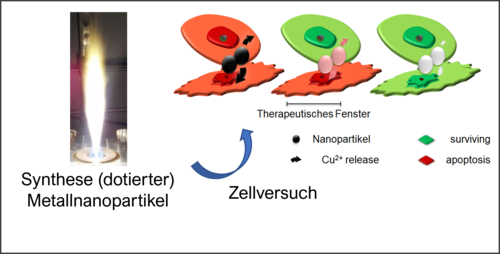Fallstudie B1
Case Study B1: Dissolution Control
Metal oxide nanoparticles are amongst the most commonly employed building blocks for advanced materials used in fields like catalysis, sensor technology or flexible electronics due to their outstanding catalytic,1 optical, and electronic properties.2 At the same time, their structure gets more and more refined into e.g., hybrid materials, in the form of nanocomposites or, increasingly, core-shell or doped nanomaterials. Metal oxide nanoparticles are also emerging as versatile materials for diagnostic and therapeutic applications.3
Metal oxide particles that dissolve inside cells, release metal ions. These can have a toxic effect on cells and can thus be beneficial in medical settings as nanomedical treatments,4 provided that the nanopaticles’ ion release can be adjusted in a controlled manner. For example, copper ions (Cu2+) form complexes with proteins and/or amino acids in biological systems. Precipitation of those complexes alters the metabolism of the cells.5
Optimising metal oxide nanoparticles at IWT
In one of their previous works, IWT analysed the dissolution behaviour of copper oxide (CuO) nanoparticles.5 Doping with iron (Fe) increased particle stability in physiologic conditions, thereby reducing cell toxicity. At IWT the copper-to-iron ratio (Fe/Cu) will be varied systematically to optimise the release profiles, either by doping or developing core-shell particles.

Analysis of particle-induced cell responses at IfADo and IUF
At IfADo, the cell responses caused by the particles developed at IWT are analysed using different cancer cell lines as well as liver cells and cells of the nervous system. Cells of the cancer cell lines will be compared to those of the non-cancerous cell lines to gain insights into possible thrapeutic strategies. After the toxic concentrations for the cells have been determined, non-toxic concentrations are used for further investigations.: With the help of RNA sequencing, molecular signatures of the different doping strategies are determined. Raman spectroscopy is used to investigate into which cell compartments the particles become incorporated.
At IUF, air-liquid interface (ALI) models of the lung are used to determine the effects of metal oxide nanoparticles on airway epithelial cells. In addition, the cell medium used for the cell culture, which contains, besides other compounds, signalling substances and metabolic products of the airway epithelial cells, is collected and used at IfADo for further studies involving nerve cells. The background here is the possible use of nanoparticles as inhalable drugs.

References and previous work
- Noman MT, Ashraf MA, Ali A, Synthesis and applications of nano-TiO2: a review. Environ Sci Pollut Res Int 26:4 (2019) 3262. https://doi.org/10.1007/s11356-018-3884-z
- He L, Tjong SC, Nanostructured transparent conductive films: Fabrication, characterization and applications. Materials Science and Engineering: R: Reports 109 (2016) 1. https://doi.org/10.1016/j.mser.2016.08.002
- Augustine R, Mathew AP, Sosnik A, Metal Oxide Nanoparticles as Versatile Therapeutic Agents Modulating Cell Signaling Pathways: Linking Nanotechnology with Molecular Medicine. Appl Mater Today 7 (2017) 91. https://doi.org/10.1016/j.apmt.2017.01.010
- Ping’an Ma et al., Enhanced Cisplatin Chemotherapy by Iron Oxide Nanocarrier-Mediated Generation of Highly Toxic Reactive Oxygen Species. Nano Letters 17 (2017) 928. https://doi.org/10.1021/acs.nanolett.6b04269
- Naatz H et al., Model-Based Nanoengineered Pharmacokinetics of Iron-Doped Copper Oxide for Nanomedical Applications. Angewandte Chemie 132 (2020) 1844. https://doi.org/10.1002/ange.201912312
Involved Partners



